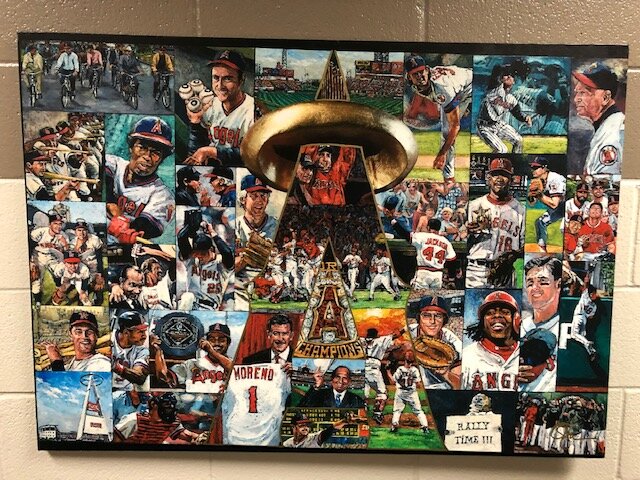Oklahoma's Day in the Sun: A Reflection of Dane Acker's No-Hitter
The following was written on March 2nd, the day after Dane Acker’s no-hitter
Michelangelo is credited with saying, “Every block of stone has a statue inside it and it’s the sculptor’s task to discover it.” As a baseball radio broadcaster, I watch games unfold from a similar perspective; continually circling at 30,000 feet above searching for a story while checking-down my list of possibilities until the essence of each game is revealed. Every game I call is a perfect game until it isn’t. Then it’s a no-hitter until it isn’t. Somedays, maybe just once in a lifetime, that ‘isn’t’ moment never comes.
Yesterday was one of those days.
The Oklahoma Sooners spent the weekend in Houston, Texas participating in the 20th annual Shriners Hospital for Children College Classic. For just the second time, this three-day nine-game event featuring some of the NCAA’s top talent pitted teams from the Big 12 Conference (Big 12) and Southeastern Conference (SEC) against each other in Minute Maid Ballpark, home of the Houston Astros. Oklahoma started the weekend with a grandiose victory over top-ten ranked Arkansas in front of a Razorback-heavy crowd. Saturday was a different story for the Sooners, falling to Mizzou after failing to do the routine things well, setting up a Sunday showdown with the LSU Tigers.
Yesterday was an unusual day. SportsTalk1400 KREF carries a local church service on-air until 11:30am on Sundays so we joined the game in progress somewhere around the bottom of the 2nd inning. This programming schedule means no pregame show as well. Now three weeks into the season, yesterday was the first weekend we’ve played as scheduled on Sunday thanks to forecasted rain in Pensacola versus Virginia and in Norman versus Illinois State. I awoke early as routine to prepare for my pregame show and batting-practice conversation with Skip Johnson. After arriving at the yard around 8:15am, I remembered there would be no pregame show and took advantage of the extra time by taking in the sights and sounds of the ballpark.
I was one of the first in the stadium. It was after passing through the security checkpoint at the players/media entrance and taking the press-elevator to the Club Level concourse that I first noticed the roof was closed over Minute Maid Park. Between an overcast Houston sky and the closed stadium lid the ballpark carried a quiet, almost reverent energy. The field lights were dimmed, as if to suggest that the ballpark itself was slow to wake from the late night before. The Spanish Radio booth I was assigned for the day was locked, and security/police were busy clearing the stadium before gates opened. I left my bags in the Milo Hamilton Pressbox and took the elevator down to field level. By this time the team had arrived. Dressed in gray pinstriped game-tops instead of their usual BP tops, they began to organize for a team photo. After aligning by height we marched the group into Center Field, the first time I’d stepped foot on the grass all weekend. When the photo-op ended the team moved into their usual pregame routines. I stayed in Center Field. Looking around, I found beauty in the details of the empty Major League stadium. Studying the trestles of the closed roof overhead, smelling the carefully manicured grass, feeling the humidity of the air on my skin. Eventually though, the field lights kicked up, the gates opened, and the serenity of that moment was gone.
I retreated to the tunnel connecting the visitor’s third base dugout to the bowels of the stadium. The gray painted cinderblock walls were adorned with elaborate oil paintings of historic moments celebrating various MLB organizations giving the hallway a contrastingly barren yet welcoming feel. I found the Visiting Clubhouse Manager’s office. I spoke with one of his staff members. He revealed an impressive collection of signed bats, cleats, stadium seats, ski goggles, and dinner plates from various Big Leaguers who had walked those same halls over the years. Standing in the midst of all this memorabilia I was again in awe of the beauty a single fleeting moment. Giants of the game—some living, some deceased—all frozen in time as memories represented by their signatures on ceramic plates.
Finally, I made my way back up to my radio booth. The teams began to take pregame Infield/Outfield. By now I’m usually scrambling—finishing my notes, organizing my audio clips, writing lineups in my scorebook as I start my pregame show. Knowing we’d be joining in progress, I took a few minutes to FaceTime my family—the only time I’ve ever done this. First my parents, then my wife. “Check out my room with a view,” I joked as I flipped the camera around to share the moment. I reveled in the moment. Then it was time for the Anthem and then First Pitch, so I said goodbye and turned my attention to the field.
Baseball is a funny game. It’s the only sport where the defense has the ball—the only sport where you can’t run-out the clock—you’ve got to compete from first pitch to last, for better or for worse. It’s a team sport made up of individuals standing alone under the microscope. “But it isn’t a social environment,” says Sooners Head Coach Skip Johnson. You can’t be afraid to fail, to be embarrassed. You have to play fast and loose and be bold enough to succeed. You have to do your job and trust the guys beside you to do the same.
From my experience, the best teams are selfless ones. Teams become dangerous when each player foregoes his own interests because he’s so committed to those of his brother. This reciprocated effort allows teams to fully commit to having each other’s back because they know their own is covered by another. No room for selfishness, no fear of failure.
There’s a purpose to conditioning. There comes a point in every season when ballplayers show up to the yard already tired from the daily grind. Physically, mentally, socially—collegiate athletics takes a toll on more than just the body. Teams who can learn to execute at this level of extreme fatigue have opportunities to be great simply by doing the routine things longer. We witnessed all of these unique qualities of the game in action yesterday.
AJ Labas would start on the mound for LSU, Dane Acker for Oklahoma. In his first outing of the year against Virginia Acker carried a no-hitter into the 5th inning. I’d described that outing in the following days as quietly effective. Not overpowering velocity, but Dane had good command of the fastball and equal feel of his off-speed. He didn’t just throw, he knew how to pitch. He worked down in the zone and let his defense make plays behind him. On Toby Rowland’s radio show I said of his debut outing, “I knew he was cruising, but suddenly I looked up and it was the 5th inning and Acker still hadn’t given up a hit.” He had 8 strikeouts in that appearance.
It was no surprise that Acker was settled in early against LSU. 91, right at the knees. He walked one, but struck out a pair in the First. Then a pair in the Second. In Third he would do the same, but got help from Catcher Justin Mitchell who erased a ‘hit by pitch,’ throwing out his fourth baserunner of the year. A rare Zaragoza error in the 4th put the leadoff man aboard for LSU. Shifted towards Right Field against the lefthanded hitting Cabrera, it seemed impossible off the bat that Tredaway would run down the ball lined in the Left Center alley. My call was clumsy. I expected the ball to get down and the runner to try for third at least. Off the bat I assumed the no-no was no-more and I couldn’t hide my disappointment in my voice. But Tredaway found another gear and made the catch crashing into the wall. Just two pitches into the inning and it seemed like LSU was in position to crack Acker. But he worked from behind against the Tigers cleanup hitter Beloso, inducing another infield groundball. This time Z grabbed it clean, and the double play extinguished LSU’s threat. Again in the 5th Acker allowed a leadoff runner by way of a hit by pitch. Acker battled. Down in the zone, one pitch at a time. Fifteen pitches later, he was headed back to the dugout having struck out three in a row stranding another man aboard. That would be the final baserunner for LSU in the ballgame.
To that point, AJ Labas had pitched a cleaner game. Acker had nine strikeouts through Five, but Labas had only allowed a single runner hitting Brady Harlan in the 2nd. Another test came for the Sooners in the 7th, but Freshman Second Baseman Logan Kohler recorded a pair of 4-3’s and Zaragoza made a play as well helping Acker work through spots three, four, and five in the LSU lineup on just four pitches.
That momentum carried over into the top of the 8th, when Justin Mitchell hit the first pitch of the inning into the Left Field seats for his first career homerun and the first hit allowed by either starter. The Sooners went down in order to follow, but the deed was done. Coming back from break, I alluded to it but wouldn’t say it outright—I recognized that Mitchell’s homerun was the first hit of the ballgame, but was cautious to directly acknowledge the significance of the moment.
“Justin Mitchell recorded the first hit of the ballgame with his solo-homerun. Acker has allowed just four baserunners; a walk, two HBPs, and an infield error…”
Acker showed his first real signs of fatigue in the 8th. There was action in the Sooners bullpen. After falling behind 3-1 on two hitters in the inning, he worked another 1-2-3 frame capped off with a line drive stolen from the 6-hole by Zaragoza.
Z would lead off the 9th with a double down the first base line, welcoming relief pitcher Fontenot to the game. Tredaway controlled the barrel hitting a ground ball to the right side advancing Zaragoza on to third. The Sooners continued to do the little things well. Oklahoma appeared in position to score again, but Fontenot got a pair of outs to strand Z ninety feet away and the Tigers headed to the bottom of the frame in just a one-run ballgame.
Bottom of the 9th.
Dane Acker walked quietly from the far dugout entrance to the loneliest place on earth—except he wasn’t alone. He had eight guys behind him prepared to lay themselves on the line for their brother. He had his conditioning, and he had a repeatable game plan. One pitch at a time. One hundred and two pitches in already, Acker struck out a pinch-hitter in the 9-spot in a six-pitch at bat. One out.
My laptop computer rebooted. I’d avoided a software update for weeks thinking, “Someday next week when I have time I’ll let it do its thing…” I never dreamed it would pick now to shut down. Ironic, isn’t it? But it didn’t matter—I didn’t need statistics. No batting average or score from Around the Big 12 would make this moment any more significant, so the call went on without.
Balls, strikes, and outs—that’s all we need to know.
Top of the order.
Falling behind 3-1, Acker appeared to be tiring. But his conditioning and process hung around. As did his teammates. With one out the leadoff-man Mathis drilled a ball to the Right Center Field track, but again Tredaway was there. Off the bat, the LSU crowd exploded. On a previous day with the roof open, who knows. But today the air was heavy and the stars were starting to align. Twenty five guys picked up the rope and pulled.
Two outs.
Again, Acker fell behind. Three balls, no strikes. The entire stadium came to life. Parents, siblings, friends and fans, all standing. All cheering. Most of them against Acker. The moment seemed to last an eternity.
Strike one.
Acker found the zone. No two-out walks, that’s the cardinal sin of pitching. Acker had come this far by executing pitch after pitch, but the tension of this moment was palpable. Process is controllable. You can’t guide a pitch, you have to throw it. You can’t ask for a strike, you have to earn it. “You’ve gotta have the guts to fail, in order to succeed,” says Skip Johnson, and you’ve got to have unwavering faith in the guys behind you. The 3-1 was hit hard on the ground towards Short, but Z was there. A quick backhand grab and a flip across the diamond, and it was done.
That’s the thing about baseball and life; the only way to succeed in either is one pitch at a time.
It’s a beautiful game. A game of failure that humbles us all. We must live our lives and play this game in the same way; sticking to the process and putting in the daily work in hopes that eventually we’ll have our day in the sun. The unfortunate truth of both life and baseball is that we don’t all get that moment. You can do all the little things right and still get beat.
But Yesterday, on a cloudy day in Houston with The Juice Box lid closed, Dane Acker and the Oklahoma Sooners got their day in the sun.
TM









